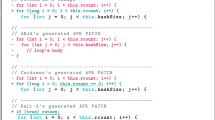Abstract
Software security has become a primary concern for both the industry and academia in recent years. As dependency on critical services provided by software systems grows globally, a potential security threat in such systems poses higher and higher risks (e.g. economical damage, a threat to human life, criminal activity).
Finding potential security vulnerabilities at the code level automatically is a very popular approach to aid security testing. However, most of the methods based on machine learning and statistical models stop at listing potentially vulnerable code parts and leave their validation and mitigation to the developers. Automatic program repair could fill this gap by automatically generating vulnerability mitigation code patches. Nonetheless, it is still immature, especially in targeting security-relevant fixes.
In this work, we try to establish a path towards automatic vulnerability fix generation techniques in the context of JavaScript programs. We inspect 361 actual vulnerability mitigation patches collected from vulnerability databases and GitHub. We found that vulnerability mitigation patches are not short on average and in many cases affect not just program code but test code as well. These results point towards that a general automatic repair approach targeting all the different types of vulnerabilities is not feasible. The analysis of the code properties and fix patterns for different vulnerability types might help in setting up a more realistic goal in the area of automatic JavaScript vulnerability repair.
The presented work was carried out within the SETIT Project (2018-1.2.1-NKP-2018-00004). Project no. 2018-1.2.1-NKP-2018-00004 has been implemented with the support provided from the National Research, Development and Innovation Fund of Hungary, financed under the 2018-1.2.1-NKP funding scheme and partially supported by grant TUDFO/47138-1/2019-ITM of the Ministry for Innovation and Technology, Hungary. Furthermore, Péter Hegedűs was supported by the Bolyai János Scholarship of the Hungarian Academy of Sciences and the ÚNKP-19-4-SZTE-20 New National Excellence Program of the Ministry for Innovation and Technology.
Access this chapter
Tax calculation will be finalised at checkout
Purchases are for personal use only
Similar content being viewed by others
Notes
- 1.
- 2.
- 3.
npm:ws:20160624.
- 4.
npm:dustjs-linkedin:20160819.
- 5.
npm:chromedriver:20161208.
References
Node Security Platform - GitHub. https://github.com/nodesecurity/nsp. Accessed 16 Oct 2018
Vulnerability DB | Snyk. https://snyk.io/vuln. Accessed 16 Oct 2018
Anderson, R., et al.: Measuring the cost of cybercrime. In: Böhme, R. (ed.) The Economics of Information Security and Privacy, pp. 265–300. Springer, Heidelberg (2013). https://doi.org/10.1007/978-3-642-39498-0_12
Chidamber, S.R., Kemerer, C.F.: A metrics suite for object oriented design. IEEE Trans. Softw. Eng. 20(6), 476–493 (1994)
Chowdhury, I., Zulkernine, M.: Using complexity, coupling, and cohesion metrics as early indicators of vulnerabilities. J. Syst. Archit. 57(3), 294–313 (2011)
Ferenc, R., Hegedűs, P., Gyimesi, P., Antal, G., Bán, D., Gyimóthy, T.: Challenging machine learning algorithms in predicting vulnerable Javascript functions. In: Proceedings of the 7th International Workshop on Realizing Artificial Intelligence Synergies in Software Engineering, pp. 8–14. IEEE Press (2019)
Gao, F., Wang, L., Li, X.: BovInspector: automatic inspection and repair of buffer overflow vulnerabilities. In: Proceedings of the 31st IEEE/ACM International Conference on Automated Software Engineering, pp. 786–791 (2016)
Jimenez, M., Le Traon, Y., Papadakis, M.: Enabling the continous analysis of security vulnerabilities with VulData7. In: IEEE International Working Conference on Source Code Analysis and Manipulation, pp. 56–61 (2018)
Le Goues, C., Forrest, S., Weimer, W.: Current challenges in automatic software repair. Softw. Qual. J. 21(3), 421–443 (2013)
Ma, S., Thung, F., Lo, D., Sun, C., Deng, R.H.: VuRLE: automatic vulnerability detection and repair by learning from examples. In: Foley, S.N., Gollmann, D., Snekkenes, E. (eds.) ESORICS 2017. LNCS, vol. 10493, pp. 229–246. Springer, Cham (2017). https://doi.org/10.1007/978-3-319-66399-9_13
Morrison, P., Herzig, K., Murphy, B., Williams, L.A.: Challenges with applying vulnerability prediction models. In: HotSoS (2015)
Neuhaus, S., Zimmermann, T., Holler, C., Zeller, A.: Predicting vulnerable software components. In: Proceedings of the ACM Conference on Computer and Communications Security, pp. 529–540, January 2007
Shin, Y., Meneely, A., Williams, L., Osborne, J.A.: Evaluating complexity, code churn, and developer activity metrics as indicators of software vulnerabilities. IEEE Trans. Softw. Eng. 37(6), 772–787 (2011)
Shin, Y., Williams, L.: An empirical model to predict security vulnerabilities using code complexity metrics. In: Proceedings of the Second ACM-IEEE International Symposium on Empirical Software Engineering and Measurement, pp. 315–317. ACM (2008)
Shin, Y., Williams, L.A.: Can traditional fault prediction models be used for vulnerability prediction? Empirical Softw. Eng. 18, 25–59 (2011)
Siavvas, M., Kehagias, D., Tzovaras, D.: A preliminary study on the relationship among software metrics and specific vulnerability types. In: 2017 International Conference on Computational Science and Computational Intelligence - Symposium on Software Engineering (CSCI-ISSE), December 2017
Smirnov, A., Chiueh, T.C.: DIRA: Automatic detection, identification and repair of control-hijacking attacks. In: NDSS (2005)
Sudo vulnerability in macOS (2020). https://www.techradar.com/news/linux-and-macos-pcs-hit-by-serious-sudo-vulnerability
Yu, Z., Theisen, C., Sohn, H., Williams, L., Menzies, T.: Cost-aware vulnerability prediction: the HARMLESS approach. CoRR abs/1803.06545 (2018)
Zimmermann, T., Nagappan, N., Williams, L.: Searching for a needle in a haystack: Predicting security vulnerabilities for windows vista. In: 2010 Third International Conference on Software Testing, Verification and Validation (ICST), pp. 421–428. IEEE (2010)
Author information
Authors and Affiliations
Corresponding author
Editor information
Editors and Affiliations
Rights and permissions
Copyright information
© 2020 Springer Nature Switzerland AG
About this paper
Cite this paper
Hegedűs, P. (2020). Inspecting JavaScript Vulnerability Mitigation Patches with Automated Fix Generation in Mind. In: Gervasi, O., et al. Computational Science and Its Applications – ICCSA 2020. ICCSA 2020. Lecture Notes in Computer Science(), vol 12252. Springer, Cham. https://doi.org/10.1007/978-3-030-58811-3_69
Download citation
DOI: https://doi.org/10.1007/978-3-030-58811-3_69
Published:
Publisher Name: Springer, Cham
Print ISBN: 978-3-030-58810-6
Online ISBN: 978-3-030-58811-3
eBook Packages: Computer ScienceComputer Science (R0)




